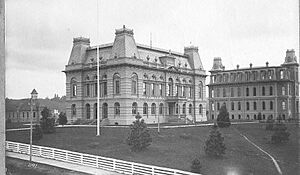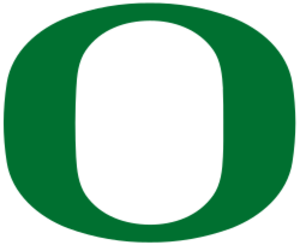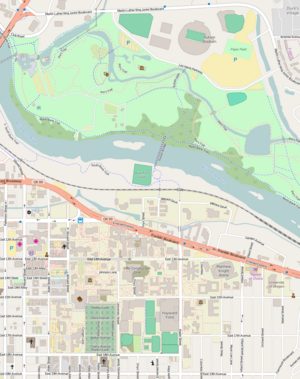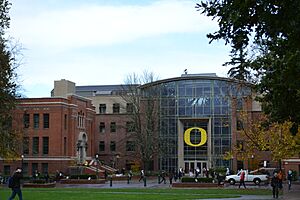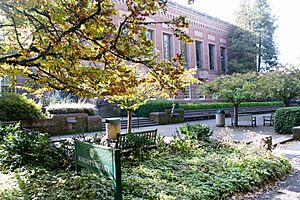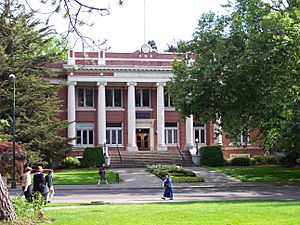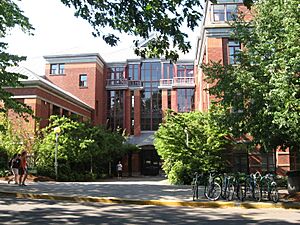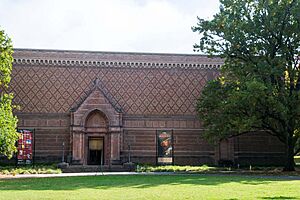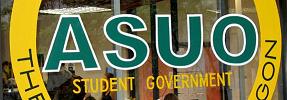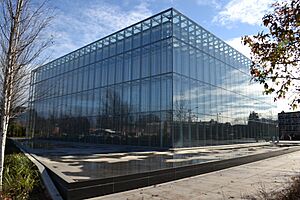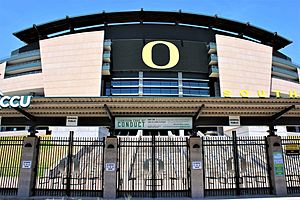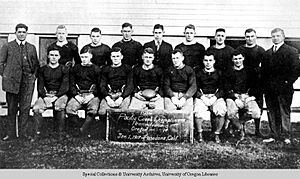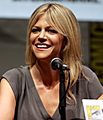University of Oregon facts for kids
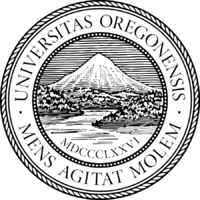 |
|
| Latin: Universitas Oregonensis | |
|
Former names
|
Oregon State University (1876–1877) |
|---|---|
| Motto | Mens agitat molem (Latin) |
|
Motto in English
|
"The Mind Moves Mountains" / (lit.) "Mind moves the mass" |
| Type | Public research university |
| Established | October 12, 1872 (established) October 16, 1876 (opened) |
| Accreditation | NWCCU |
|
Academic affiliations
|
|
| Endowment | $1.63 billion (2023–24) |
| Budget | $1.45 billion (2024–25) |
| President | Karl Scholz |
| Students | 23,834 (fall 2024) |
| Undergraduates | 19,970 (fall 2024) |
| Postgraduates | 3,864 (fall 2024) |
| Location |
,
,
United States
44°02′39″N 123°04′33″W / 44.0443°N 123.0758°W |
| Campus | Midsize city, 295 acres (1.19 km2) |
| Other campuses | |
| Newspaper | Daily Emerald |
| Colors | Green and Yellow |
| Nickname | Ducks |
|
Sporting affiliations
|
|
| Mascot | The Oregon Duck |
 |
|
The University of Oregon (UO, U of O or Oregon) is a large public university in Eugene, Oregon, United States. It was started in 1876. The university has nine colleges and schools. It offers 420 different study programs for students. UO also has other locations like the Ballmer Institute for Children's Behavioral Health in Portland, Oregon, and the Oregon Institute of Marine Biology in Charleston, Oregon. There is also the Pine Mountain Observatory in Central Oregon.
UO's campus is about 295 acres (1.2 km²) and is located near the Willamette River. Most of the school's programs use a 10-week "quarter system" for classes. The university is known for its "Very high research activity." It is also a member of the Association of American Universities, a group of leading research universities. Since 2014, UO has been managed by its own special board of trustees.
Students who play sports at UO are called the Oregon Ducks. They are part of the Big Ten Conference in the NCAA Division I. The Oregon Ducks have eighteen sports teams. They are especially famous for their football team and their track and field program. These two sports are even part of the school's "O" logo design. In the summer of 2022, UO hosted the 2022 World Athletics Championships. This was the first time this big event was held in the United States.
The university has a long connection with Nike, Inc. and its co-founder Phil Knight. Mr. Knight is a former student. He has given over $1 billion to UO since the late 1980s, with much of it supporting sports. The school's "O" logo was designed by Nike in 1998. Many sports buildings on campus are built with help from Mr. Knight and Nike.
The university's motto is mens agitat molem. This Latin phrase means "The Mind Moves Mountains." It comes from an ancient poem called the Aeneid by Virgil.
Contents
University History
How the University Started
Before the university was created in 1872, most colleges in Oregon were connected to religious groups. The Oregon State Legislature wanted to create a state university in 1872. A group of citizens from Eugene, called the Union University Association (UUA), worked to make sure the new university would not be connected to any religion. They succeeded in changing the bill. The state legislature passed the bill in 1872, creating the school as Oregon State University. People in Eugene raised $27,500 to buy 18 acres of land for the campus.
Early Years of UO
The university opened in 1876. It was first called "Oregon State University." Its only building was University Hall. In the first year, 155 students attended classes with five teachers. The first students graduated in 1878. Five students received their degrees. In 1881, the university almost closed because it owed $8,000. Luckily, Henry Villard donated $7,000 to help save it. There were ideas to combine the university with what is now Oregon State University in 1913 and 1932, but these ideas were not approved.
Growing into a University
The university grew a lot when Prince Lucien Campbell was president from 1902 to 1925. The school's money, number of students, buildings, and teachers all increased greatly. Many new schools were also started during his time. These included the School of Music (1902), the School of Education (1910), the School of Architecture (1914), the College of Business (1914), the School of Law (1915), the School of Journalism (1916), and the School of Health and Physical Education (1920).
In 1917, the university started using a "quarter system" for its classes. This means the school year is divided into three main terms. This system is still used today.
The University of Oregon Medical School started in Portland in 1887. It later became its own separate school in 1974, now known as Oregon Health Sciences University. The Institute of Molecular Biology was also created at the university in 1959.
The university was even a filming location for the 1978 movie National Lampoon's Animal House.
A Special Time for UO
The 1960s and 1970s were a very good time for the university. In 1964, UO was ranked 25th in the country for important research grants. In 1969, UO joined the Association of American Universities, a group of top research universities.
Many students earned advanced degrees during this time. From 1970 to 1979, over 2,600 students earned doctoral degrees.
Recent History of UO
In recent years, UO has built many new buildings. These include the Matthew Knight Arena, the Ford Alumni Center, and new dorms. This happened while the state provided less money to the university. Because of this, tuition fees for students increased.
In 2016, the university removed the name of Frederic Stanley Dunn from a dormitory. He was a department head in the 1920s and 30s. His name was removed because of his past connection to the Ku Klux Klan, a group known for its harmful beliefs.
More Private Support
Starting in the 1990s, the state of Oregon began giving less money to the university. This led to some programs being reduced or closed. For example, many teacher training programs were stopped.
To make up for this, UO started fundraising campaigns. In 2001, University President Dave Frohnmayer began a campaign to raise $600 million. They raised even more than that, thanks to large gifts from people like Phil Knight.
In 2014, the university aimed to raise $2 billion from donors. This goal was later increased to $3 billion in 2018. Phil Knight and his wife Penny gave huge donations. In 2016, they gave $500 million to create the Phil and Penny Knight Campus for Accelerating Scientific Impact. This was the largest donation ever given to a public research university at that time. They gave another $500 million to the Knight Campus in 2021. In 2022, Steve Ballmer also gave $425 million for a new center focused on children's behavioral health.
"University of Nike"
The school's "O" logo was officially adopted by the university in 2002. It was designed by Nike and first used by the sports teams in 1998. The inside of the "O" is said to look like Hayward Field, which is the university's track and field stadium. The outside of the "O" is said to look like Autzen Stadium, UO's football stadium.
Phil Knight has helped pay for hundreds of millions of dollars worth of building projects on UO's campus since the late 1980s. He helped with the renovation of the Main Library, now called the Knight Library, and the building of the William W. Knight Law Center.
Mr. Knight is a big supporter of UO's sports teams. He has helped build and manage many sports facilities. Major newspapers have even called the university the "University of Nike." A book called The University of Nike talks about how much Nike and Phil Knight have influenced the university.
Becoming More Independent
In 2010, UO's president, Richard Lariviere, suggested a new way for the university to be managed and funded. This plan aimed to create an independent board and a large fund to support the university in the future. The idea was to give UO more control and a steady source of money.
In 2013, the Oregon Legislature passed a law that created local governing boards for the state's three largest universities. In 2014, the University of Oregon became an independent public body. It is now governed by the Board of Trustees of the University of Oregon. Supporters of this change believed it would give the university more freedom and help with funding.
Michael H. Schill became the university's president in 2015. In 2022, he left to become president at another university. Karl Scholz has been president since July 1, 2023.
University Campus
The UO campus covers about 295 acres (1.2 km²) and has eighty buildings. It is also like a park with over 3,000 trees, including 500 different types of trees. The campus is next to the West University neighborhood and Pioneer Cemetery. Eugene is close to natural places like the Willamette River, the Cascade Mountains, and the Pacific Ocean. The city of Portland is also only a two-hour drive away.
Many of the university's buildings are arranged around large open areas called quadrangles. The university is known for a special way of planning buildings called the Oregon Experiment. This idea says that people who will use a building should help design it. It also suggests building in many small steps instead of one big project.
Most academic buildings are along East 13th Avenue. Student recreation and union centers are in the middle of campus. Dorms are on the east side. Sports facilities are in the southern part of campus, with Autzen Stadium and PK Park across the Willamette River. The university also has other locations, like a large facility in downtown Portland and the Oregon Institute of Marine Biology in Charleston.
The University of Oregon is home to the Jordan Schnitzer Museum of Art and the Museum of Natural and Cultural History. Since 2012, the campus has been smoke and tobacco free.
Old Campus and Memorial Quad
The oldest part of campus is in the northwest. The first building, University Hall, opened in 1876. It was later named after Judge Matthew Deady. In June 2020, Deady's name was removed, and it was temporarily renamed University Hall. The second building, Villard Hall, was finished in 1886. It was named after Henry Villard, who helped the university with money. Both University and Villard Halls are important historical landmarks.
South of the Old Campus is the Memorial Quad. This area has the main library, Knight Library, at one end and the Lillis Business Complex at the other. Nearby are Prince Lucien Campbell Hall, the tallest building on campus, and the Jordan Schnitzer Museum of Art. Chapman Hall, which houses the Robert D. Clark Honors College, is also close by.
Central Campus
The center of campus has a mix of academic buildings, administration offices, and student recreation centers. Johnson Hall holds the offices for the university president and other leaders. Across 13th Avenue from Johnson Hall is "The Pioneer" statue, a bronze sculpture of a pioneer. Another statue, "Pioneer Mother," is on the other side of Johnson Hall. The two statues are placed so they can "see" each other through the building's windows.
Lawrence Hall is home to the School of Architecture and Allied Arts. Allen Hall, next to Lawrence Hall, houses the School of Journalism and Communication. The Erb Memorial Union (student union) and the recreation center are also in this central area.
Science Complex and East Campus
The Lorry I. Lokey Science Complex has several science buildings on the east side of campus. Willamette Hall, home to the physics department, is a key part of this complex. Other buildings like Cascade Hall (geology), Deschutes Hall (computer science), and Streisinger Hall were completed in 1989.
The Lokey Laboratories are also in this complex. They are used for advanced scientific research. The Allan Price Science Commons and Research Library was renovated and reopened in 2016.
The northeast part of campus has the Ford Alumni Center and Matthew Knight Arena. Most of the rest of the eastern campus is for student dorms. Carson Hall offers dining services and dorms. The Living-Learning Center, opened in 2006, combines dorms, classrooms, and study areas. The newest dorm, the Global Scholars Hall, opened in 2012.
South Campus
The middle of south campus is where many of the sports facilities are located. Hayward Field, home to the Ducks track and field team, is here. It has hosted many important track and field events.
West of the sports facilities is Pioneer Cemetery. Further west are the buildings for the College of Education. The Knight Law Center is in the southeast corner of campus. The Many Nations Longhouse and the Museum of Natural and Cultural History are also in this area.
Knight Campus
The Phil and Penny Knight Campus for Accelerating Scientific Impact is a huge science campus. It is located north of Franklin Boulevard. Phil and Penny Knight gave a billion dollars to this campus. The goal of the Knight Campus is to help grow Oregon's biotechnology industry and create economic growth for the state.
Other Locations
The Riverfront Research Park is a small facility used for creating new technologies, like research on artificial intelligence. It is also home to the Zebrafish Information Network (ZFIN), a database about zebrafish.
In 2022, UO bought the campus of the closed Concordia University in Portland. This became the main UO Portland campus. The university also leases space in downtown Portland.
Sustainability Efforts
The University of Oregon is known for its focus on sustainable design. Its architecture program is highly ranked for "Sustainable Design Practice and Principles." The university received a "B+" grade for its sustainability efforts in 2011.
UO has a plan that requires all new buildings or renovations to use sustainable design. The Lillis Business Complex, completed in 2003, was a leader in this. It earned a LEED Silver rating, which is a high award for green buildings. As of 2016, 15 buildings on campus had earned LEED Silver or higher ratings.
University Organization
| Colleges and Schools | |||
|---|---|---|---|
|
|||
The university is officially recognized by the Northwest Commission on Colleges and Universities. This means its programs meet high standards.
How UO is Managed
The university is managed according to its own rules, called The Constitution of the University of Oregon. This involves a team effort where teachers, students, and staff all have a say. The University Senate, mostly made up of teachers, helps make decisions for the whole university.
The UO Board of Trustees took control in 2014. They have the power to manage the university and make important decisions.
John Karl Scholz became the 19th president of the university in 2023.
Campus Safety
The University of Oregon Police Department helps keep the campus safe.
Academics and Learning
| Business | 88 |
| Education | 15 |
| Law | 94 |
As of 2024, UO offers 420 different degree programs. Students come from all 50 U.S. states, four U.S. territories, and 91 countries. In Fall 2023, the most popular undergraduate majors were Pre-Business Administration and Psychology.
The University of Oregon has nine colleges and schools. The College of Arts and Sciences covers many subjects in arts and sciences. The Charles H. Lundquist College of Business teaches subjects like accounting and marketing. The College of Design offers degrees in design and planning. The College of Education trains future teachers.
The Robert D. Clark Honors College is a special program for select students. It has small class sizes. The School of Journalism and Communication is one of the oldest journalism schools in the U.S. The School of Law started in Portland and moved to Eugene in 1915. The School of Music and Dance offers programs in music and dance.
The University of Oregon Medical School, which started in 1887, became a separate institution in 1974. It is now known as Oregon Health & Science University.
Becoming a UO Student
The University of Oregon's undergraduate admissions process is "selective." This means they choose students carefully. For students starting in Fall 2019, about 81.6% of applicants were accepted.
For students who started in Fall 2019, the middle 50% of SAT scores ranged from 560 to 660 for reading and writing, and 540–650 for math. ACT scores ranged from 22 to 28. The average high school GPA for new students was 3.65.
Teachers and Staff
As of May 2022, at least 19 UO teachers have been chosen for the National Academy of Sciences. As of Fall 2023, the university has 2,097 faculty members. This includes 782 teachers who are on a path to become permanent professors.
Research at UO
The university is a member of the Association of American Universities. It is also known for "Very High Research Activity." This means UO does a lot of important research. The university has 13 research centers and institutes. It also has nine "research core facilities" that help with experiments.
University Libraries
The University of Oregon Libraries serve the campus with many books, resources, and technology. UO is the only university in Oregon that is a member of the Association of Research Libraries. The main library is the Knight Library. It has collections for humanities, social sciences, government documents, and more. Other library locations include:
- The Design Library
- The John E. Jaqua Law Library
- The Loyd & Dorothy Rippey Library at the Oregon Institute of Marine Biology
- The Mathematics Library
- The Portland Library & Learning Commons
- The Science Library
The UO Libraries also have Scholars' Bank, which is an online collection of research papers and other works by University of Oregon scholars. The Special Collections & University Archives hold unique items, like the writings of author Gardner Fox and a rare collection of Japanese votive slips.
Student Life at UO
| Race and ethnicity | Total | ||
|---|---|---|---|
| White | 62% |
|
|
| Hispanic | 16% |
|
|
| Two or more races | 10% |
|
|
| Asian | 7% |
|
|
| Black | 3% |
|
|
| Unknown | 1% |
|
|
| Foreign national | 1% |
|
|
| American Indian/Alaska Native | 1% |
|
|
| Economic diversity | |||
| Low-income | 23% |
|
|
| Affluent | 77% |
|
|
Special Events
UO hosts many special events. One of the most popular is the Oregon Bach Festival. This music festival is supported by donors and is the only major music festival connected to an American university. It started in 1970 and now brings hundreds of musicians and over 40,000 visitors each year. The festival has featured famous artists and often commissions new musical works. A recording from the Bach Festival even won a Grammy Award in 2001.
Clubs and Groups
There are over 250 student groups at the University of Oregon. Most of these groups have their offices in the Erb Memorial Union. The University of Oregon has three student-run singing groups that perform without instruments: Divisi, On the Rocks, and Mind the Gap.
Student Media
The University of Oregon has many student-run media groups. These include the Daily Emerald newspaper, the Oregon Commentator, and Ethos Magazine. The university also has two radio stations: KWAX (classical music) and KWVA (campus radio).
Student Government
There are two main student government groups at the University of Oregon. The largest is the Associated Students of the University of Oregon (ASUO). Its goal is to help students grow socially, culturally, and educationally. Students also have a voice in the University Senate and on the university's board of trustees.
The second largest student government group is the Residence Hall Association (RHA). This group speaks for all students who live in the dorms. They help improve dorm life and suggest ideas to University Housing.
Graduate Student Union
The University of Oregon Graduate Teaching Fellows Federation (GTFF) was formed in 1976. It represents graduate students who work at the university. It is one of the oldest graduate student unions in the U.S. In 1993, the GTFF successfully negotiated for health insurance paid by the university.
In 2014, the GTFF went on strike for the first time. They wanted a pay raise and paid sick leave. The strike lasted a week. A compromise was reached, and the strike ended.
Student Facilities and Housing
The Erb Memorial Union (EMU) is the student union building. It is a central place for student life. The EMU had a big renovation and expansion project from 2013 to 2016. The new building, opened in 2016, has better dining options, offices, and meeting spaces.
South of the EMU is the Student Recreational Center (SRC). The Lyllye Reynolds-Parker Black Cultural Center, named after Lyllye-Reynolds Parker, opened in 2019.
There are several dorms on campus. Kalapuya Ilihi opened next to Global Scholars Hall and houses 531 students. Unthank Hall was completed in 2019 and opened to students in 2021.
University Athletics
The University of Oregon is part of the Big Ten Conference and the Division I Football Bowl Subdivision. The university's sports teams have won 28 NCAA team championships. They have also had 60 individual NCAA champions in track and field. Because of its strong track program and connection to Nike, Eugene is known as "Track Town, USA."
The two main rivals of the Oregon Ducks football team are the Washington Huskies and the Oregon State Beavers. The football rivalry with Oregon State University is one of the oldest in the country. The two teams play each other almost every year since 1894.
The university competes in 14 sports, including football, basketball, cross country, track and field, baseball, and soccer. Club sports also compete at a high level in sports like Rugby and Rowing.
Cross country and track and field are the most successful sports programs at UO, with 20 NCAA championships. These programs have produced many world-class athletes like Steve Prefontaine and Alberto Salazar. Nike was started by former track and field coach Bill Bowerman and former UO track runner Phil Knight.
The football team started in 1893 and played its first game in 1894. They won their first Rose Bowl in 1917. The 1938–39 men's basketball team, called the "Tall Firs," won the first-ever NCAA basketball tournament.
Baseball was an official sport in 1908 but was stopped in 1981. In 2007, the athletic director announced plans to bring baseball back.
Connection with Nike
The University of Oregon's Athletic Department and the university itself have a long and close relationship with Nike Inc.. This is because Nike was founded by two UO alumni. Nike founder Phil Knight is one of the biggest donors in UO's history. He has invested a lot in developing and supporting the sports programs.
Mascot
The mascot of the University of Oregon is the fighting duck. The famous Disney character Donald Duck has been the mascot for many years. This happened because of an agreement between Athletic Director Leo Harris and Walt Disney in 1947. A formal contract was written in 1973.
Fight Song
The university's fight song is "Mighty Oregon." It was written in 1916 by professor Albert Perfect and student John DeWitt Gilbert.
Notable People
Alumni
- '''Notable alumni of the University of Oregon include:'''
-
Sam Adams, former Mayor of Portland
-
Lee Bollinger, President of Columbia University
-
Bill Bowerman, Track and Field coach and co-founder of Nike, Inc.
-
Walter Houser Brattain, Nobel Prize winner in Physics
-
Neil Goldschmidt, former Governor of Oregon
-
James Ivory, Oscar-winning director
-
Phil Knight, co-founder of Nike, Inc.
-
Kaitlin Olson, actress
-
William P. Murphy, Nobel Prize winner in Physiology or Medicine
-
Chuck Palahniuk, author of Fight Club
-
Paul Simon, former U.S. senator
-
Nguyen Thien Nhan, former Deputy Prime Minister of Vietnam
-
Ron Wyden, U.S. senator from Oregon
-
Ryan Zinke, former U.S. Secretary of the Interior
-
Hilda Heine, President of the Marshall Islands
Many famous people have graduated from the University of Oregon. These include two Nobel winners, 16 Pulitzer Prize winners, and 19 Rhodes Scholars. There are more than 195,000 University of Oregon alumni around the world. The Ford Alumni Center is a place for alumni to connect.
Some well-known alumni include: university presidents Lee Bollinger and Gene Block, TV host Ann Curry, author Ken Kesey (who wrote One Flew Over the Cuckoo's Nest), businessman Phil Knight (who founded Nike, Inc.), NFL quarterbacks Marcus Mariota and Justin Herbert, author Chuck Palahniuk, U.S. Senator Ron Wyden, actress Kaitlin Olson, and Hilda Heine (president of the Marshall Islands).
Faculty and Staff
Current and former teachers and staff at the University of Oregon include one Nobel Prize winner and 11 members of the National Academy of Sciences. Two Oregon researchers have also received the President's National Medal of Science.
Notable current and former faculty include: architect Arthur Erikson, biochemist Brian Matthews, neuroscientist Michael Posner, and Nobel Prize winner David Wineland.
Famous former athletic staff include: track coach Bill Bowerman (who co-founded Nike, Inc.) and football coach Chip Kelly.
See also
 In Spanish: Universidad de Oregón para niños
In Spanish: Universidad de Oregón para niños


